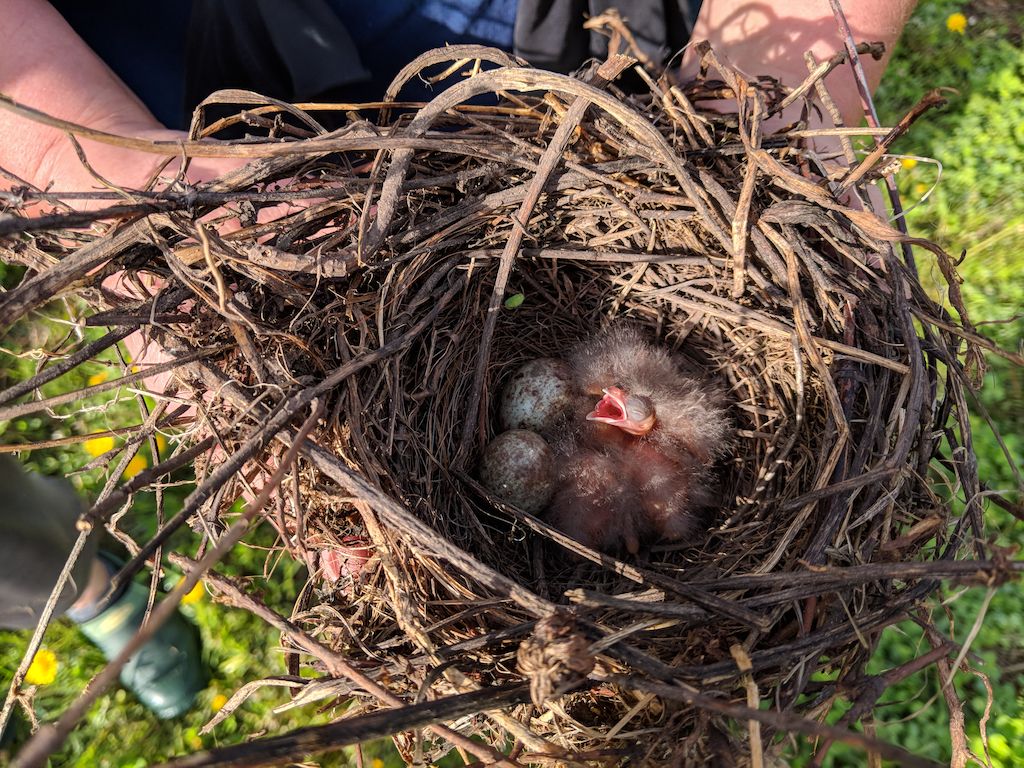Wildlife Conservation
Living on the prairies means we see a lot of wildlife. Our team is committed to ensuring wildlife has their natural habitats protected.
Bees
Every effort is made to sustain the wild bee population, with retention of treefall along the edges of the woods (wild bees nest in the treefall), and the placement of wild bee boxes for them to nest in. The wild bees are prolific in the spring and the orchard is completely abuzz with their activity as soon as the flowers open. Without pollination, there would be no berries! In fact, wild bees are said to be over 50 times more efficient at their work than cultured bees are and, unlike cultured bees, they work in colder weather and in more adverse conditions. We like to call cultured bees ‘fairweather workers’; therefore, we strongly encourage the wild bees. Additionally, we limit the orchards and gardens to zero insecticides, favouring natural methods of control such as BT, nets, floating row cover, soap wash, manual insect removal and cleaning up of debris.
Wild bee nests are placed in various areas around the orchard, particularly in the treelines
Keeping Wildlife Out of the Orchards
Local deer and moose populations, as well as geese, feed off the clover planted in the headlands near the North Orchard treeline, keeping them out of the orchards.
Wild mule deer
Bears are frequently seen around the farm area. In 2019, the bears were seen in the North Orchard several times.
Lots of Birds
Wild birds, particularly ducks and geese, are encouraged to live in our surrounding ponds. We plant clover around the headlands and between the Haskap rows for them to feed on. As we work in the orchards, it is entertaining to watch the migratory birds from their return in the spring, through nesting, raising their young, and the migration in the fall.
Ducks often use our ponds. Photo by Dave Morash.
Bald eagles and other predatory birds feed off voles and small animal wildlife, controlling their populations in the orchard. We love to see them fly overhead and perch on the treelines. The orchards are surrounded by leased fields; we encourage the farmer to plant items such as lentils, oats and barley, keeping the acreage in production and providing food for the wildlife and humans alike. It is interesting to observe the seasons of agricultural work, of which we are a part.
Uncommon to our area in Saskatchewan is the whooping crane. Their original natural nesting habitat is in the wetlands of northern Alberta and southwestern Northwest Territories. North America has only two types of cranes, one being the whooping crane, the other the sandhill crane. In the 1940’s, the whooping crane was on the verge of extinction with approximately 20 in the wild and in captivity. Now, thanks to conservation efforts, the number is up over 800.
You can recognize the whooping crane in flight with their long necks straight out and their long dark legs trailing behind. They can be heard several kilometres away with their "guard call" warning their partners about potential danger. Partner cranes will also call in unison early in the morning, after courtship, and when defending their territory.
In May, 2019, we were very fortunate to see several flocks of whooping cranes fly over our property. Their distinctive markings and loud calls made it easy to recognize them. We hope they continue to fly over our fields as we enjoy watching nature flourish.
Blackbirds like to build their nests in our Haskap bushes, however, they also like to eat the berries.
Ever since our Haskap bushes started producing berries, we’ve covered them with netting as soon as the berries started to ripen. In the spring of 2019, we decided to try something different. We installed three Bird Gard™ systems in the orchards. Please see the description below on how the system works. In our set up, we also included two 'kites' (they look like hawks) and one sound cannon, which scare off the birds plus keep out the deer and geese.
Bird Gard works by broadcasting digital recordings of actual bird distress calls, at a frequency birds hear and recognize, throughout the protected area. When birds hear Bird Gard’s distress calls, they perceive danger and avoid the area as a result.
In the past when we have netted the Haskap bushes, we often found nests in them. It was at this time that we relocated the nests to wind break trees next to the orchard. The birds were happy because they were protected in the trees, and we were happy because they couldn’t eat our berries. Since the new Bird Gard™ system is active during the growing season, it prevents the birds from building nests in the first place.
During the netting process in 2018, we found many nests filled with baby eggs
The babies were definitely not happy
Operation Blackbird Relocation to the wind break trees
Once the babies were relocated, the final netting was put in place












